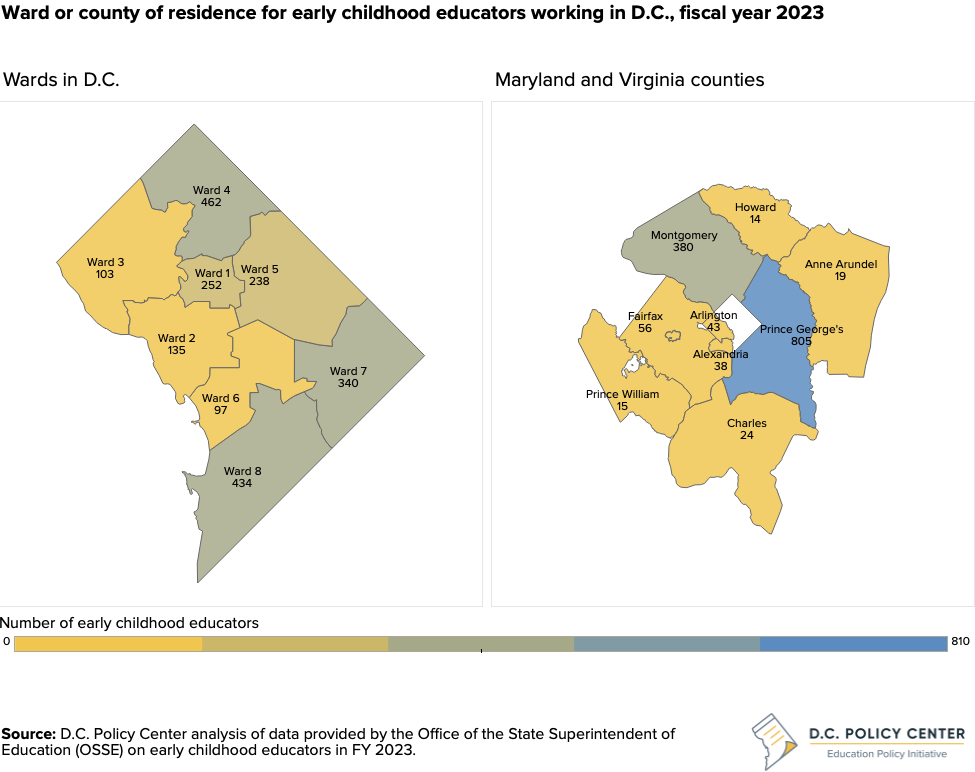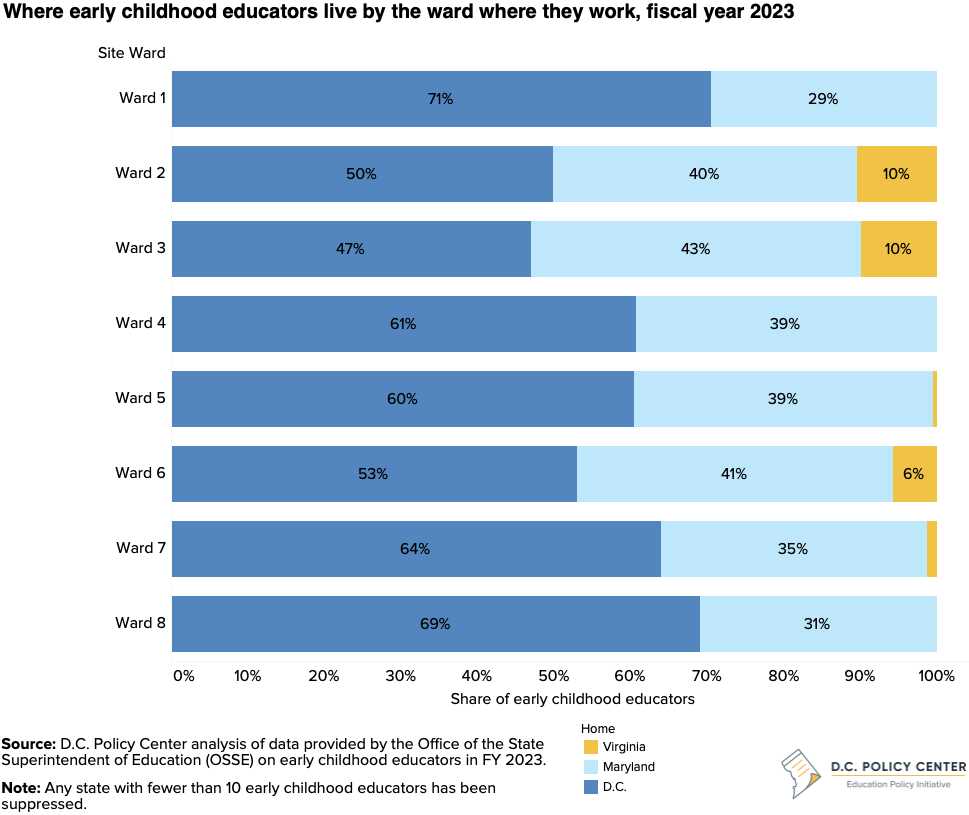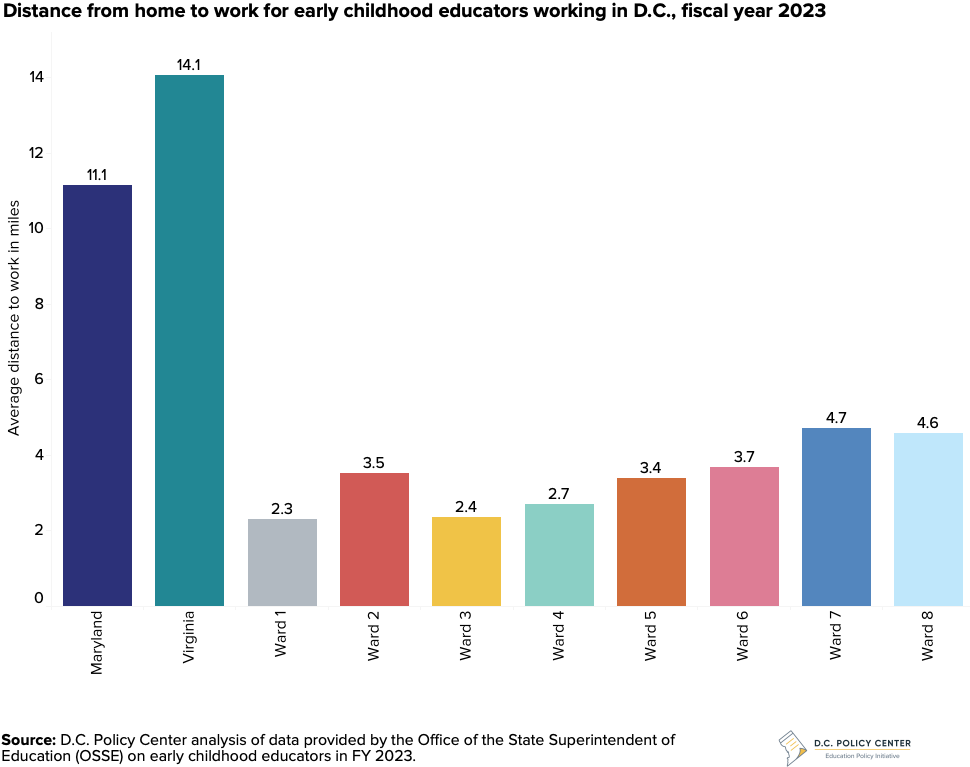
This report is the second in a three-part series that examines the housing challenge for essential workers in the District of Columbia in the context of early childhood educators. For the purposes of this study, the term “early childhood educators” refers to educators who are working with infants, toddlers, and preschool-aged children in child-facing roles at child development centers licensed by the Office of the State Superintendent of Education (OSSE). Part I looks at where early childhood educators work. Part II examines where early childhood educators live, which is often driven by affordability of housing, even if it means longer commute times. Part III closes with implications for what types of housing early childhood educators can afford given their earnings, and where housing affordability for early childhood educators exists in D.C. and the region. It also estimates the amount that would be necessary to close the housing affordability gap across different neighborhoods of D.C. for these educators.
This report is a part of a larger project at the D.C. Policy Center that examines how employers, philanthropy, and the government can create a scalable solution that can provide affordable housing for essential workers, especially those who are at the beginning of their careers.
Other reports in this series:
The District’s early childhood educators live throughout the region, some facing longer commutes than others. In addition to shorter commute times, there are many workplace-level benefits and other advantages associated with living close to the workplace. For the purposes of this analysis, early childhood educators are defined as those working with infants, toddlers, and preschool ages in child-facing roles at child development centers licensed by the Office of the State Superintendent of Education (OSSE). Within a workplace, individuals who live close to where they work have fewer absences and therefore are likely to be more productive and cost efficient.1 Shorter commutes, in addition to being associated with lower costs, are also associated with higher rates of retention, which can in turn improve child development and child outcomes through more stable caregiver interactions and relationships.2, 3 This is particularly critical for child development facilities as many early childhood educators exited during the pandemic4 and the sector is still facing significant shortages.5 In addition, overall worker wellbeing can improve when workers live closer to their workplace. Research shows longer commutes negatively impact one’s mental health and increase anxiety and depression,6 which often leads to lower satisfaction with one’s work and greater turnover.

Data notes
D.C. Policy Center undertook this analysis with the purpose of better understanding where District early childhood educators live and work, what budget constraints they may face in finding affordable housing close to work, and how this differs by demographic group. OSSE shared data on early childhood educators with the D.C. Policy Center to conduct analyses addressing the research questions of this report series. Data shared by OSSE included residential address, work address, supplemental payments that early educators received from the Early Childhood Educator Pay Equity Fund in fiscal years 2022 and 2023 (when OSSE distributed payments directly to early educators via an intermediary), full- or part-time status, and job title.
Data on early childhood educators shared by OSSE (see Data Notes for more information) for fiscal year (FY) 2023 show that of the early childhood educators with a valid address on file:7
- Most early childhood educators (59 percent) who work in D.C. also live in D.C.
- Within D.C., early childhood educators are most likely to reside in Ward 4, Ward 7, or Ward 8 (all with more than 300 educators).
- Maryland is home to more than a third of early childhood educators working in D.C. (37 percent), and Virginia is home to 5 percent (these percentages sum to more than 100 due to rounding).

Commutes for early childhood educators
Facilities in Wards 1, 7, and 8 have the highest share of D.C. residents working as early childhood educators. In contrast, for facilities in Wards 2, 3, 4, 5, and 6, approximately 40 percent of early childhood educators live in Maryland. Facilities in Wards 2 and 3 have the most early childhood educators living in Virginia (still a low share at 10 percent).

This geographic distribution of early childhood educators’ residences has implications for commute distances. For all early childhood educators working in D.C., the average distance is 6.8 miles.8 For early childhood educators living in D.C., the average commute distance is lower, at 3.6 miles. Within D.C., commute distance is highest for early educators living in Ward 7 and Ward 8 at 4.7 miles and 4.6 miles, respectively, which likely means more travel time. However, the average commute distance for early childhood educators living in Maryland is 11.1 miles, three times as long as the average D.C.-based commute distance. Those living in Virginia have an even farther commute at 14.1 miles on average, although this only represents a small share of the early childhood educator workforce.

The housing affordability implications of where early childhood educators live and work will be explored in the next part of this series.
Endnotes
- Ma, L & Ye, Runing. 2019. Does daily commuting behavior matter to employee productivity? Retrieved from https://www.sciencedirect.com/science/article/abs/pii/S0966692318307269
- Grissom, J & Santelli, F. 2022. A Bad Commute: Does Travel Time to Work Predict Teacher and Leader Turnover and Other Workplace Outcomes? Retrieved from https://edworkingpapers.com/ai22-691#:~:text=Research%20suggests%20that%20longer%20commute,reducing%20job%20attachment%20and%20embeddedness
- See https://fred.stlouisfed.org/series/CES6562440001 which shows that across the nation, the number of employees in the childcare sector declined by 33 percent in a matter of one month between March and April of 2020, and as of September 2023, was still below the pre-pandemic levels.
- See https://fred.stlouisfed.org/series/CES6562440001 which shows that across the nation, the number of employees in the childcare sector declined by 33 percent in a matter of one month between March and April of 2020, and as of September 2023, was still below the pre-pandemic levels.
- Pickert, R & Rockman, O. 2022. Child-Care Workers are quitting the industry for good in the U.S. Retrieved from https://www.bloomberg.com/news/articles/2022-04-27/child-care-workers-are-quitting-the-industry-for-good-in-the-u-s?leadSource=uverify%20wall
- Chatterjee, K., Clark, B., Martin, A. & Davis, A. (2017). The Commuting and Wellbeing Study: Understanding the Impact of Commuting on People’s Lives. Retrieved from https://travelbehaviour.com/wp-content/uploads/2017/10/caw-summaryreport-onlineedition.pdf
- Out of the 3,862 early childhood educators, 3,526 (92 percent) had a valid address on file. Almost all without a valid address did not have any value in this field, and 2 were excluded because their residence was greater than 500 miles away from their place of work.
- This distance is estimated from data provided by the Office of the State Superintendent of Education (OSSE) for this study.
